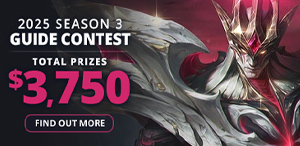Not Updated For Current Season
This guide has not yet been updated for the current season. Please keep this in mind while reading. You can see the most recently updated guides on the browse guides page
x
 Getting Started on Supporting
Getting Started on Supporting
x
Did this guide help you? If so please give them a vote or leave a comment.
You can even win prizes by doing so!
Vote
Comment
I liked this Guide

I didn't like this Guide

 Thank You!
Thank You!
Your votes and comments encourage our guide authors to continue
creating helpful guides for the League of Legends community.
Introduction

Please keep in mind that this guide contains a lot of in game terminology and is intended for experienced players who wish to pick up on support. Completely new players will have a difficult time understanding some parts of the guide.
So, let's get started!

Supports are split into different categories –
tank supports, mage supports, and utility supports.
Other people may categorize the different kind of supports into
poke supports, kill lane supports, and sustain supports.
Tank supports tend to have hard CC, amplifies the carry's damage, and go all in on the enemy laners.
Mage supports tend to do a lot of damage by poking the enemy down with excessive burst without taking damage.
Utility supports tend to offer sustain or CC to protect the carry.
There are also off-meta supports, but those will not be discussed here.
Technically, you could pick anyone and support with it. But a lot of it depends on both the enemy team and your team. Pick a champion that offers something your team is lacking.
For example, pick a tank when your team is mostly squishy. Pick a CC heavy support if your team lacks CC. Pick a disengage support if the enemy team has a full engage team comp. Pick whatever your team needs. You get the idea.
Another way is to pick a support that counters the enemy bot lane matchup.
Generally, poke supports win against kill lane supports, kill lane supports win against sustain supports, and sustain supports win against poke supports.
None of this is absolute, since there are many other factors that determine whether a lane wins or loses. However, the best thing to do is to pick a support that you’re comfortable playing with.
There are many champion guides online that will suggest runes and masteries for specific support champions, so suggested support runes and masteries will not be elaborated in this guide. There are general support rune pages, however, and those can also be found in other similar guides. You can always customize your pages based on personal preference.

Standard supports grab
but some supports also grab
Always start with a yellow trinket ( Stealth Ward), but remember to switch to a red trinket (
Stealth Ward), but remember to switch to a red trinket ( Sweeping Lens) once you have
Sweeping Lens) once you have  Sightstone. Please upgrade your trinket to
Sightstone. Please upgrade your trinket to  Oracle Lens at level 9.
Oracle Lens at level 9.
There are three starting support items: Relic Shield
Relic Shield
 Spellthief's Edge
Spellthief's Edge
 Ancient Coin
Ancient Coin
Typically, tank melee supports (i.e. Braum,
Braum,  Taric) start with
Taric) start with  Relic Shield, since it gives good pushing power and nice sustain.
Relic Shield, since it gives good pushing power and nice sustain.
AP or utility/poke based range supports (i.e. Lux,
Lux,  Nami) tend to start with
Nami) tend to start with  Spellthief's Edge, which offers good harass, mana regen, and ability power.
Spellthief's Edge, which offers good harass, mana regen, and ability power.
 Ancient Coin is mainly for added health regen, which works well on supports like
Ancient Coin is mainly for added health regen, which works well on supports like  Soraka.
Soraka.
Some people prefer having other item starts such as Doran's Ring, but these starting meta support items offer a good source of gold income.
Doran's Ring, but these starting meta support items offer a good source of gold income.
Get Health Potions with your remaining gold.
Health Potions with your remaining gold.
There are three starting support items:
Typically, tank melee supports (i.e.
AP or utility/poke based range supports (i.e.
Some people prefer having other item starts such as
Get

After you get to lane with your carry, your main goal is to reach level 2 before the enemy lane does. To hit level 2, you gain experience from the first wave and then three melee creeps from the second wave. Help push the wave by:
- Auto attacking the minions without messing up the cs.
- Zone or auto attack/poke the enemy laners.
- Try not to stand there and do nothing, although there are certain exceptions.
If your lane reaches level 2 first, go full aggressive and attempt to grab a kill or burn some summoner spells (even doing extra damage puts you at an advantage), but always know your limits. If they are probably going to hit level 2 before you, play safe until you catch up in levels.
Don’t farm when your carry is there, but you can farm up the minions when your carry goes back to base. That way, you gain gold and experience without letting your carry lose anything. However, always stay safe.
You can also try to help your carry last hit minions or push. Try to set up the farm so that your carry can last hit more easily under tower. For last hitting minions under tower, auto the caster minions once. Do not hit the melee minions under tower. For pushing, hit the minions that aren’t being aggro-ed.
It is more difficult for enemies to CS under tower, so it is advised to keep the wave pushed. However, that makes your lane more susceptible to being ganked. If you want to play safe, you can keep the wave frozen or pushed back. That way, the enemy laners will have a harder time initiating a fight or poke you and your carry.

You can also try to help your carry last hit minions or push. Try to set up the farm so that your carry can last hit more easily under tower. For last hitting minions under tower, auto the caster minions once. Do not hit the melee minions under tower. For pushing, hit the minions that aren’t being aggro-ed.
It is more difficult for enemies to CS under tower, so it is advised to keep the wave pushed. However, that makes your lane more susceptible to being ganked. If you want to play safe, you can keep the wave frozen or pushed back. That way, the enemy laners will have a harder time initiating a fight or poke you and your carry.


Please ward while you are in lane to maintain vision control of your opponents. Good spots to ward are either in the river tri-brush, the brush in the river, or further up near the

It is good to ward river with your trinket after hitting level 2 if you’re pushed up. That way, you can prevent a level 2 enemy jungler gank. Your carry can ward there after your trinket ward runs out.
Also, try to buy a
Counterwarding is when you take out your opponent’s ward to deny them vision, so it is always important to note where your opponents have placed wards. It is also nice to alert your teammates if your enemy has placed wards in the river area, in case your teammates wish to gank your lane.
After getting

Wards aren’t useful if you don’t watch the map and track your opponents. Remember to
- Always watch the map to look for potential ganks coming down the river.
- Alert your carry with pings if you see potential danger.
- Call MIA if your lane opponents leave the lane.
- Follow your lane opponents if they leave to fight your jungler or other laners.
- Also watch other lanes to see what is going on, such as calling MIA for them, seeing where enemies are on other parts of the map, and overlooking enemy global ults.
Each champion have different item builds, and item builds are also dependent on what your team needs and what the enemy team composition is. I will give an overview on what items you can build next as support, but look at specific champion guides for additional details.

Everyone has different preferences on what to get for the first couple of backs, but here are some suggestions. One option is that you can grab boots, a Control Ward, and pots on the first back, so you could roam early and get deep wards. Upgrade to
Control Ward, and pots on the first back, so you could roam early and get deep wards. Upgrade to  Frostfang and then grab a
Frostfang and then grab a  Control Ward and potions for AP supports. It’s totally okay to get
Control Ward and potions for AP supports. It’s totally okay to get  Sightstone before boots, since vision is crucial in this current meta. I personally prefer upgrading my support item (i.e. spellthief’s edge into
Sightstone before boots, since vision is crucial in this current meta. I personally prefer upgrading my support item (i.e. spellthief’s edge into  Frostfang), add a
Frostfang), add a  Control Ward, and then work on building a
Control Ward, and then work on building a  Sightstone, but base your first items on your current situation and personal preference.
Sightstone, but base your first items on your current situation and personal preference.
Some people prefer upgrading their support items into the Sightstone upgrade instead of the support item upgrade. Use your best judgement.
Sightstone upgrade instead of the support item upgrade. Use your best judgement.

As for boots, it is based on the champion you’re playing, the enemy team, and personal preference.
Core items are heavily dependent on your champion, what your team needs, and what the enemy team has. There are specific champions that have deviated builds, but here is a general guideline on what items you can get.
For example, get Locket of the Iron Solari if the enemy team has AP damage, since it offers magic resist and armor, good stats, and a decent shield for teamfights.
Locket of the Iron Solari if the enemy team has AP damage, since it offers magic resist and armor, good stats, and a decent shield for teamfights.
For AP heavy supports, build standard support items if you are behind. If you are ahead as an AP heavy support, you can grab some damage items such as Just remember to have enough health and defense stats so you can live long enough to provide your utility in fights. Ultimately, it is up to you to be able to decide on which item to buy, since that is an essential part of winning the game.

Everyone has different preferences on what to get for the first couple of backs, but here are some suggestions. One option is that you can grab boots, a
Some people prefer upgrading their support items into the

As for boots, it is based on the champion you’re playing, the enemy team, and personal preference.
 Mobility Boots or
Mobility Boots or  Boots of Swiftness can be used on tankier supports such as
Boots of Swiftness can be used on tankier supports such as  Thresh,
Thresh,  Braum, and
Braum, and  Leona.
Leona. Ionian Boots of Lucidity can be used for ranged utility supports for better cooldown reduction.
Ionian Boots of Lucidity can be used for ranged utility supports for better cooldown reduction.- AP heavy champions can go for
 Sorcerer's Shoes.
Sorcerer's Shoes.
Core items are heavily dependent on your champion, what your team needs, and what the enemy team has. There are specific champions that have deviated builds, but here is a general guideline on what items you can get.
For example, get
 Randuin's Omen or
Randuin's Omen or  Frozen Heart is nice if there are enemy AD champions, especially AD attack speed champions.
Frozen Heart is nice if there are enemy AD champions, especially AD attack speed champions. Mikael's Blessing is great for clearing CC from a carry and provides an extra heal, which is good against CC heavy team comps.
Mikael's Blessing is great for clearing CC from a carry and provides an extra heal, which is good against CC heavy team comps. Banner of Command is also a good pick, since it gives the magic resist aura, extra AP, and ability to create a strong pushing lane.
Banner of Command is also a good pick, since it gives the magic resist aura, extra AP, and ability to create a strong pushing lane. Redemption is also a good item overall for AOE damage and heal for your team during teamfights.
Redemption is also a good item overall for AOE damage and heal for your team during teamfights.
For AP heavy supports, build standard support items if you are behind. If you are ahead as an AP heavy support, you can grab some damage items such as Just remember to have enough health and defense stats so you can live long enough to provide your utility in fights. Ultimately, it is up to you to be able to decide on which item to buy, since that is an essential part of winning the game.

Do you protect your teammates or do you dive?
Generally, try to protect your teammates, but this depends on your champion and situation. Do remember that it’s better to keep your teammates alive so that they can kill the enemy team. Use your CC, heals, peels, damage, tankiness, whatever it takes to keep your teammates alive. Don’t die needlessly, but if you have to, sacrifice yourself if it means it’ll keep your teammates alive (so they can do more damage to the enemies).
For some supports, you can initiate a teamfight with your abilities (namely, your ult), but it is better to use your abilities to peel for your carries over chasing an enemy. Each case is situational, and there are specific champion guides that will elaborate more on how to play teamfights.
In simpler terms, don't be a selfish scumbag and go help your teammates.

Whew. We got to the end of the guide, yippee! A lot of playing support is based on personal preference, and it is something that will develop over practice. Thank you for reading my guide, and please leave comments below. It would be awesome to hear what you guys think, and I would love suggestions on how to make this guide better! Hope you learned a lot through this guide, and good luck on summoner’s rift!
Go to the League of Legends Wiki for comprehensive information on items, champions, etc.
To look up summoner's stats and other champion stats, go to OP.GG or LOLKING.
To check out how you compare with other players on certain champions, refer to LoL Skill.
To look up your game, refer to LoL Nexus.
For suggestions on what to build on champions, Pro Builds is also a good resource.
Another good resource is LoL Class.
Other sites for great information are on Solo Mid, LoL Nexus Champions, and MobaFire itself.
To look up summoner's stats and other champion stats, go to OP.GG or LOLKING.
To check out how you compare with other players on certain champions, refer to LoL Skill.
To look up your game, refer to LoL Nexus.
For suggestions on what to build on champions, Pro Builds is also a good resource.
Another good resource is LoL Class.
Other sites for great information are on Solo Mid, LoL Nexus Champions, and MobaFire itself.
Thank you for helping me create this guide! I couldn't have done it without help from these great resources and pictures from the internet (and shout out to the people who helped me along the way). You can also check those out!
An in depth guide for supporting s4
Support 101 - A Comprehensive Guide
How to carry as a support in season 6
An in depth guide for supporting s4
Support 101 - A Comprehensive Guide
How to carry as a support in season 6







 12,644
12,644
 6
6




You must be logged in to comment. Please login or register.